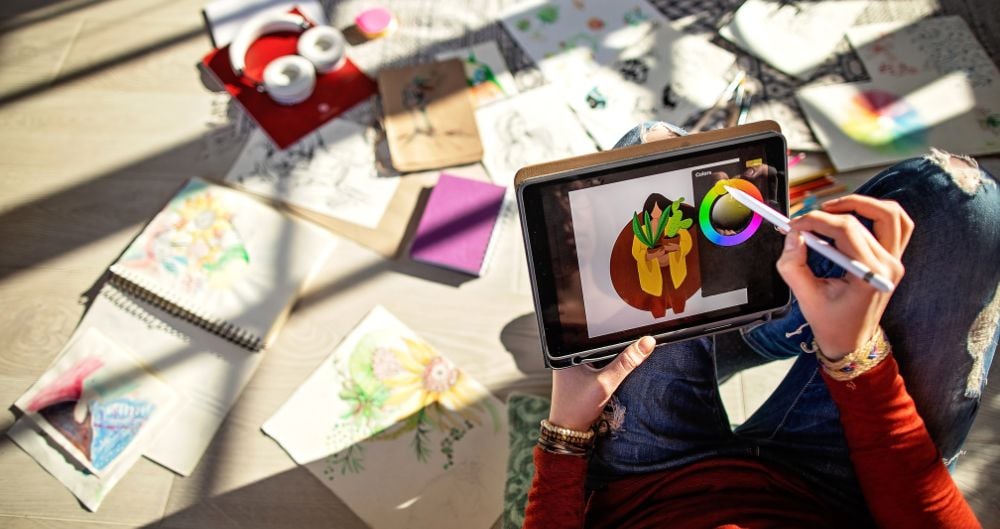Associate Degree in Digital Design: A Complete Guide (2024)

Learn what’s involved in earning an Associate degree in Digital Design. We'll cover what the degree is, its pros and cons, the steps to get it, how long it takes, online options, what you’ll study, and potential career paths.
Key Points
- An associate degree in Digital Design provides a solid foundation in digital art, graphic design, and multimedia production.
- The program typically takes two years to complete and offers hands-on training in industry-standard software and tools.
- Graduates can pursue entry-level roles in graphic design, web design, digital marketing, and more, or continue their education with a bachelor's degree.
- Pros include affordability, flexibility, and a quicker path to the workforce, while cons may include limited job opportunities compared to a bachelor's degree.
How Long Does it Take to Get an Associate Degree in Digital Design?
An associate degree in Digital Design typically takes two years of full-time study to complete. This timeframe is based on the standard academic calendar, with students taking a full course load (around 15 credits per semester) and progressing through the program in a linear fashion.
However, the actual duration of the program may vary depending on several factors, such as:
- Enrollment status (full-time or part-time)
- Transfer credits accepted
- Availability of courses and scheduling
- Pace of individual student progress
Some students may be able to complete the program in less than two years by taking advantage of accelerated or summer course options, while others may take longer due to personal or academic circumstances.
What to Expect from an Associate Degree in Digital Design
An associate degree in Digital Design provides a comprehensive introduction to the field of digital art and design. Students can expect to develop a strong foundation in the following areas:
- Proficiency in industry-standard design software (e.g., Adobe Creative Cloud)
- Understanding of design principles and visual communication
- Hands-on experience with digital media, including photography, video, and animation
- Exposure to web design, user experience (UX), and digital marketing
- Development of a professional portfolio showcasing their work
- Opportunities for internships or capstone projects to gain real-world experience
The curriculum is designed to balance theoretical knowledge with practical application, allowing students to gain the skills and confidence needed to enter the workforce or continue their education with a bachelor's degree.
What Can You Do with a Digital Design Associate Degree?
Graduates of an associate degree program in Digital Design have a variety of career paths and educational opportunities available to them.
Graduate School Preparation
For those interested in pursuing a more advanced degree, an associate degree in Digital Design can provide a solid foundation for continuing their education. Graduates may choose to transfer to a four-year university to earn a bachelor's degree in areas such as Graphic Design, Multimedia Design, or Visual Communications. Some may even opt to pursue a master's degree (Master of Fine Arts or Master of Design) or a doctoral degree (Ph.D. in Design or related field) to further specialize in their chosen area of digital design.
Entry-Level Digital Design Roles
With an associate degree in Digital Design, graduates can seek entry-level positions in the following fields:
- Graphic Designer
- Web Designer
- Digital Illustrator
- Digital Photographer
- Social Media Designer
- Marketing/Advertising Designer
- Production Artist
- Multimedia Specialist
Career Opportunities
Some of the potential career opportunities for individuals with an associate degree in Digital Design include:
- Graphic Designer
- Web Designer
- User Interface (UI) Designer
- User Experience (UX) Designer
- Digital Illustrator
- Multimedia Artist
- Social Media Designer
- Digital Marketing Specialist
- Advertising/Promotional Designer
- Production Artist
According to the Bureau of Labor Statistics (BLS), the average annual salary for graphic designers, which includes many digital design roles, is $58,910, and the job outlook is projected to grow 3% from 2022 to 2032, about as fast as the average for all occupations.
Final Thoughts
An Associate Degree in Digital Design is a valuable option for those interested in pursuing a career in the dynamic and ever-evolving field of digital art and design. This two-year program provides a solid foundation in the technical and creative skills needed to succeed in entry-level design roles or to continue their education with a bachelor's degree. Whether you're looking to kickstart your design career or lay the groundwork for further study, an Associate Degree in Digital Design is worth considering.
Should this guide not quite meet your standards, check out the other guides below to find one that aligns better with your preferences:
- Associate Degree in Business Administration: A Complete Guide (2024)
- Associate Degree in Emergency Medical Technician: A Complete Guide (2024)
- Associate Degree in Finance: A Complete Guide (2024)
- Associate Degree in Marketing: A Complete Guide (2024)
- Associate Degree in Paralegal: A Complete Guide (2024)

Harold Roldan is a Growth team member at Dreambound. With a background in IT, he works with data and automation to improve team efficiency and workflows. He spends his free time playing musical instruments or studying data, computers, and technology.



